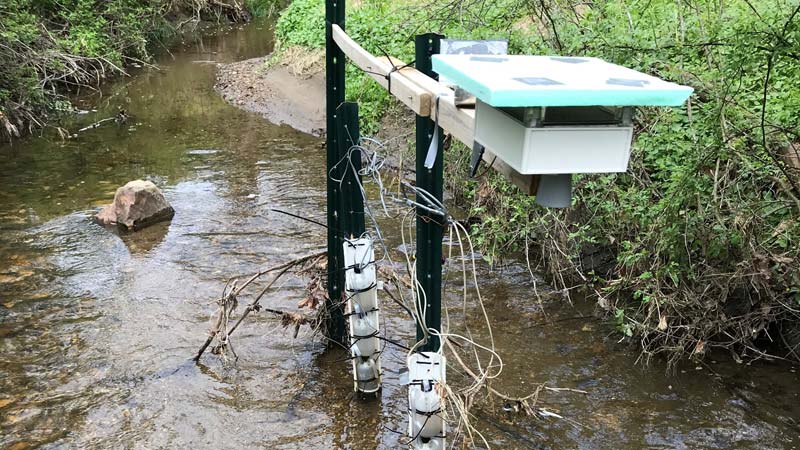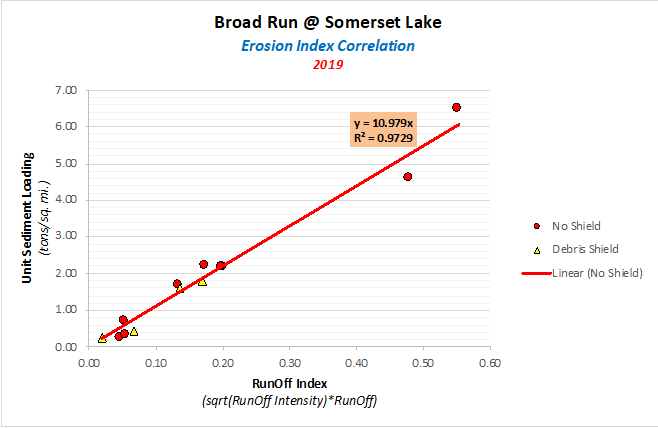-
Dave Yake posted a new activity comment 4 years ago
Rory,
I have copied the comments from our email so that others can view them… thanks again.
dave
The U20-001-04’s (13 ft range) accuracy is 3-6 mm, so that needs to be considered. It also needs to be compensated with barrometric pressure (not mentioned in the report) which adds additional inaccuracies.
With respect to the barometric…[Read more]
-
Dave Yake wrote a new post 4 years ago
Evaluation by the Save our Water, Watershed Hydrologic Analysis Team, Marion Waggoner and Dave Yake.
Background
Broad Run drains a 10 km2 watershed straddling southeastern Pennsylvania and northwest […]

-
Dave Yake wrote a new post 5 years ago
The Problem
An EnviroDIY Monitoring Station, which includes a turbidity sensor, was installed in late May 2018 on the Broad Run Creek upstream of Somerset Lake. The Mayfly board enclosure with solar panel was […]
-
Dave Yake wrote a new post 5 years ago
By Marion Waggoner and Dave Yake
Background
We (Save Our Water) started a program to monitor the Broad Run stream in late 2014 with the primary objective of establishing a base line of stream flow throughout the […]
-
I have a similar issue with the need to collect a water sample. We have an array of LEC water monitors in the various UNT’s into Great Marsh. One is downstream of the Turnpike service plaza and we are seeing the usual EC spikes correlated with the winter weather. However, a few are very large and don’t seem to be weather correlated hence the nee to get water sample since they are relatively short duration of a few hours or less.
I came across a low cost 12 Volt fountaintain pump that is perfect for pumping a water sample into a collection bottle. I built a 4 channel sampling system based on this pump with a Mayfly controlling four pumps. When the EC gets above a prescribed level the pump is activated for about 12 seconds, enough time to fill a 500cc sample bottle. The software in the mayfly resets when the EC drops below the set threshold and advances to the next port and runs on the next EC spike.I attached a few pictures of the system I built. However I may have missed the weather events causing EC spikes.
If there is interest I can write up a blog with Mayfly code and construction details.
-
can only add one image at a time
-
..and here are the sample collection bottles
-
-
-
-
Dave Yake became a registered member 6 years ago
 Welcome to EnviroDIY, a community for do-it-yourself environmental science and monitoring. EnviroDIY is part of WikiWatershed, an initiative of Stroud Water Research Center designed to help people advance knowledge and stewardship of fresh water.
Welcome to EnviroDIY, a community for do-it-yourself environmental science and monitoring. EnviroDIY is part of WikiWatershed, an initiative of Stroud Water Research Center designed to help people advance knowledge and stewardship of fresh water. New to EnviroDIY? Start here

Thankyou so much for doing such detailed work. I’d been thinking of a boom situation for some measurements. However the atmospheric temperature will vary.
Great work guys. We are also interested in these sensors and have also been considering a boom-type setup.
I think it might be worth getting one of these to see if it’s fit for our purpose.
Hey Dave,
As part of my technical institute’s graduation requirements, I’m currently designing a project to test the accuracy of MaxBotix’s sensors (as well as a $75 vented pressure transducer) to determine their applicability for streamflow monitoring. I’m also a hydrometric tech so do put a lot of thought into collecting accurate data.
With that said, I do have a couple of thoughts to consider in regards to how your test was designed.
Here they are in point form for brevity’s sake:
Anyhow, I don’t mean to be a downer. I basically just listed these points as I’ll be critiquing your work in a literature review as part of my project.
Really though I think it’s great that you’ve gone to all this work to test the sensor. I learned a few ideas from reading this that I’ll be incorporating into my tests.
Give me a shout at gallaugher.consulting@gmail.com if you are up to chatting about your tests and helping me to design mine.
Rory,
I have copied the comments from our email so that others can view them… thanks again.
dave
With respect to the barometric pressure: a. Pressure sensor for depth: Remember that we are compensating for barometric pressure changes in the Onset logger by having a parallel sensor following barometric pressure. Not sure he understood that. b. Also, with respect to the ultrasonic sensor, the barometric pressure has a very minimal effect on the speed of sound in air. Marion remembers that it is 2 orders of magnitude below the effect of both temperature and relative humidity (which is much lower than the temp effect.) So, really the only important effect is the temperature effect on speed of sound.
We discarded using the ultrasonic sensor on a stilling well due to the signal dropouts which were somewhat erratic as to when they occurred, but clearly were connected to temp changes from high to low which induced some kind of condensation on the walls (that caused deflection of the wave). Similarly, we actually dispensed with the stilling well on the Onset depth logger just for convenience. So, stilling well experience is not something where got comparison data. The Final result comparisons were not data from stilling wells..
We don’t believe your comments about the metal boom having a significant impact on correct. If you calculate the change in dimension for a uniform metal (ie..
no bimetallic effect) that is heated on only one side (eg. sun) while the other side is cool (shady side) then you can see that the metal is much less than wood. For example, CTE’s for metal will run around 1 * 10**-5 while wood will be at least 10X higher. Still, neither will show much bending with temperature differentials that we see in outside testing. That said, however, it is a concern for planned experiments, and easy to manually measure the separate distance from the boom to the target over the temp range..
We would be interested in your results if/when available…. In particular, it would be helpful to see what the temperature effect (water temp) has on a pressure sensor logger (such as the Onset or the CTD sensor used in the Stroud logger stations..